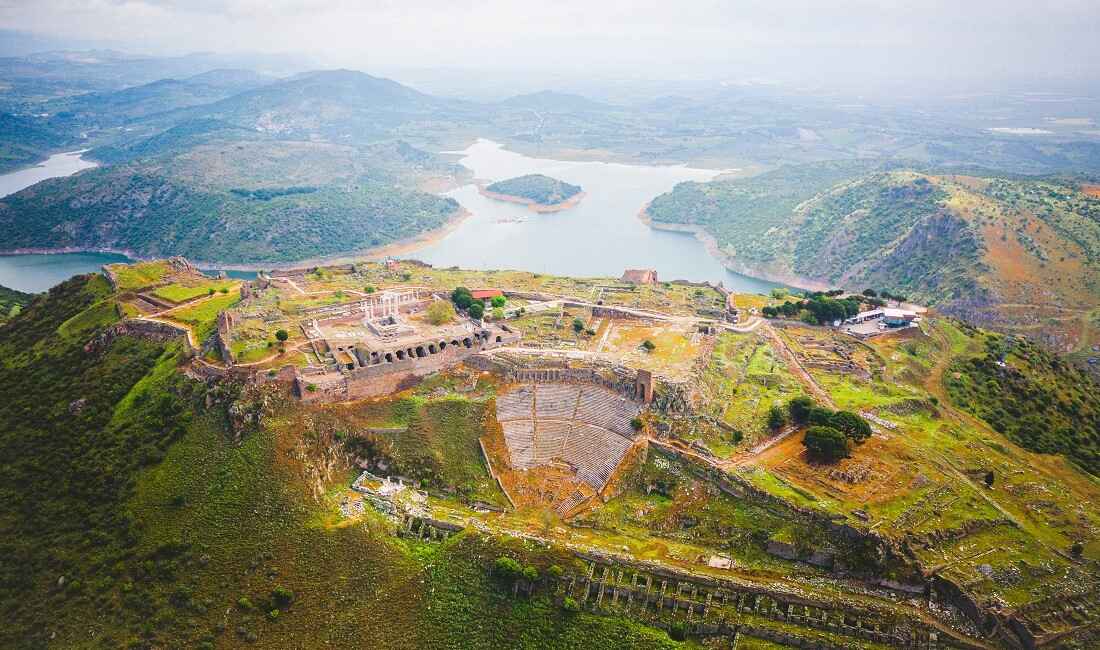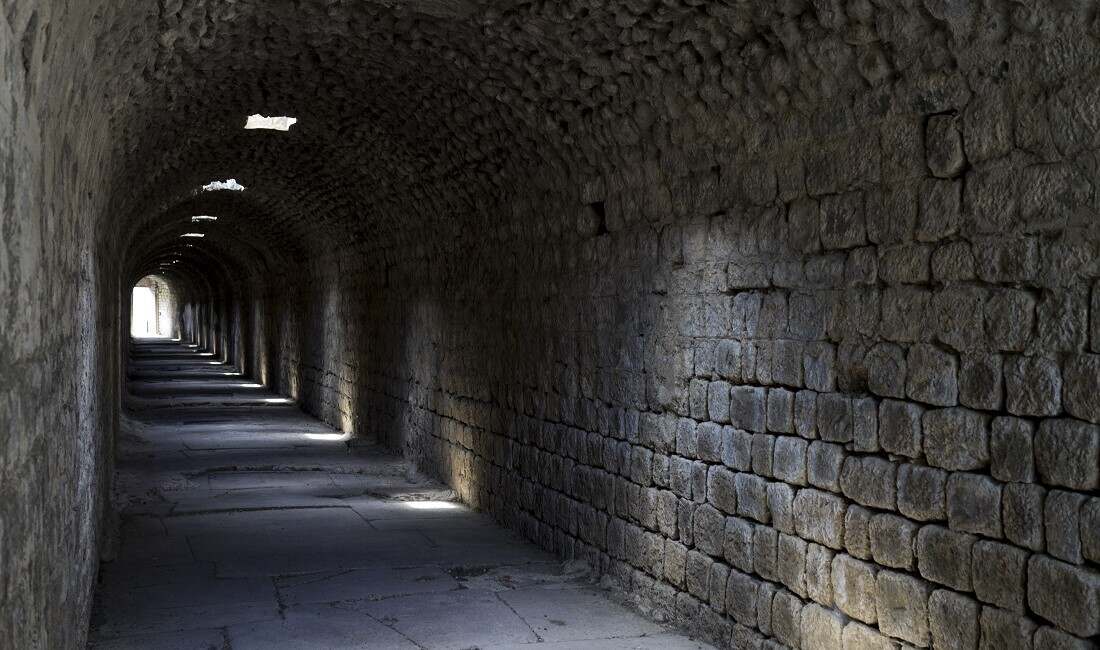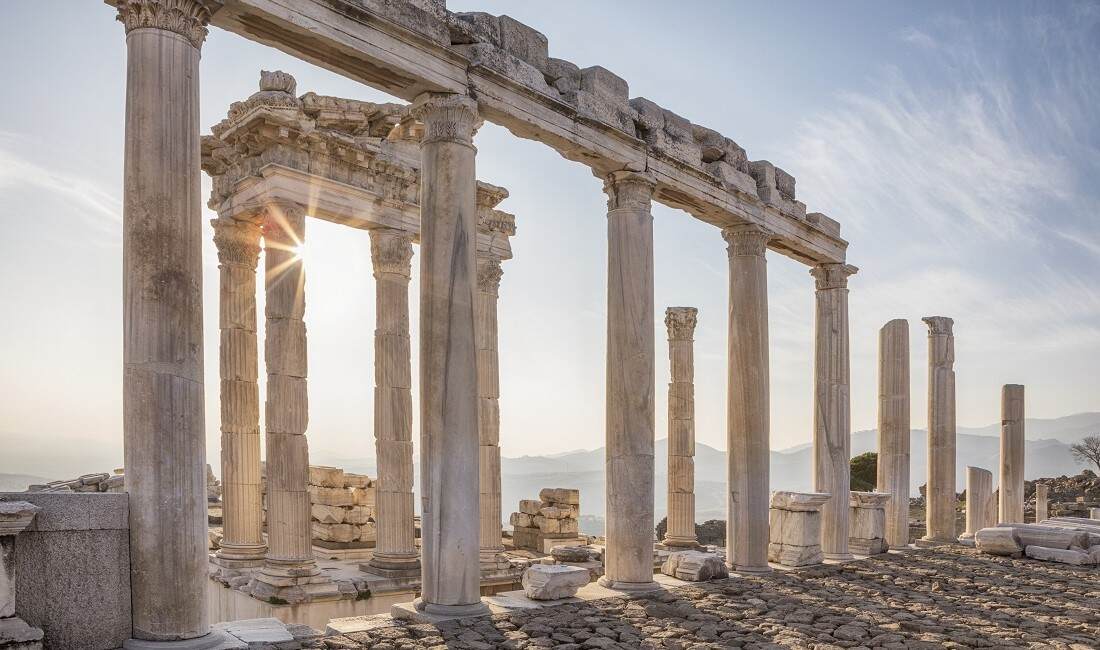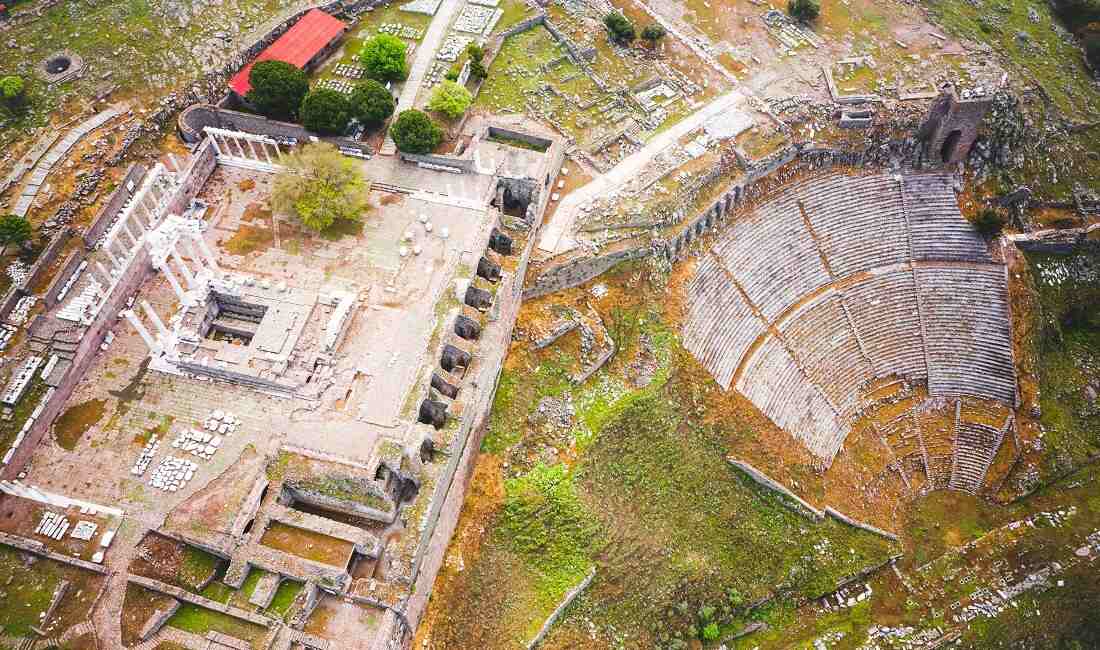
Pergamon, which was also called Pergamum, was an old city in the northwest of what is now Turkey. It started in the 3rd century BCE and became essential during the Hellenistic era. The Attalid dynasty ruled the area for almost 200 years and had their capital in Pergamon.
In ancient times, Pergamon was an important cultural, political, and intellectual center. The city was known for its impressive library, which contained over 200,000 volumes, second only to the library in Alexandria. Pergamon was also famous for its medical center, considered one of the best in the ancient world. The city was also home to many important temples and religious sites, including the Great Altar of Zeus.
Pergamon’s importance continued into modern times. European explorers rediscovered the city in the 19th century. Many of its ancient artifacts were taken to museums in Europe and America. Today, Pergamon is a popular place for tourists to visit. People go from every corner of the globe to witness its old ruins, such as the Acropolis, the theater, and the Asclepion medical center.

Pergamon is on a steep hill that looks out over the surrounding valleys and plains. This gave the city natural protection and a good view of the area. In addition, the town was strategically located along the ancient trade routes that linked the Mediterranean world with the east, making it an important center of commerce and culture.
The climate of Pergamon was characterized by long, hot summers and mild, rainy winters. The city was in a fertile area known for growing crops, especially grapes, and olives. In addition, the site was full of lush forests, rolling hills, and winding rivers, which made it an excellent place for hikers and people who like to be in nature.
Several other ancient cities and attractions surrounded Pergamon, including the nearby coastal town of Izmir, the ancient city of Ephesus, and the ancient city of Troy. The region was also known for its hot springs and thermal baths, believed to have medicinal properties, and was frequented by visitors from across the ancient world.
Today, the modern city of Bergama occupies the site of ancient Pergamon. It is home to several important archaeological sites, including the Acropolis, the Asclepion medical center, and the Red Basilica. The surrounding area is also home to several natural attractions, including the Dikili beaches and the Kazdağı National Park, known for its rugged mountain terrain and scenic hiking trails.

Greek mythology is a big part of Pergamon’s early history. One story says that a son of Hermes founded the city. However, archaeological findings suggest that the city was founded in the 3rd century BCE by the Greek General Philetaerus, a trusted advisor to Lysimachus, one of Alexander, the Great’s generals. When Lysimachus died in 281 BCE, Philetaerus took advantage of the situation to establish his kingdom in the area. Under Philetaerus and the people who came after him, Pergamon became one of the most critical places for culture and learning in the Hellenistic world. The Attalid dynasty, which ruled Pergamon from 241 to 133 BCE, was known for its patronage of the arts and sciences, and the city’s library was second in size only to the Library of Alexandria. Pergamon was also renowned for its sculpture and architecture, with its artists producing such masterpieces as the Great Altar of Zeus and the Athena Parthenos statue.
The Attalid dynasty, which ruled Pergamon from 282 to 133 BCE, marked the city’s golden age during the Hellenistic period. The Attalids were known for patronizing the arts, sciences, and literature. Their reign saw the city’s transformation into a center of learning and scholarship. Pergamon’s library was one of the most important institutions of the ancient world, with over 200,000 volumes in its collection. The library attracted scholars from across the Mediterranean world. It was said that the Pergamene rulers even went so far as to prohibit the export of papyrus from keeping the secrets of their library safe. Pergamon was also renowned for its medical center, the Asclepion, which was dedicated to the god of healing, Asclepius. The Asclepion was considered one of the best places to get medical care in the ancient world. People came from Greece and even farther away to get treatment there. Under the Roman Empire, Pergamon’s reputation as a center of culture and learning grew. During this time, many of the city’s most impressive buildings were built.

After the Roman Empire defeated King Attalus III of Pergamon in 133 BCE, Pergamon became an important cultural center in the Roman province of Asia. The Romans recognized the city’s rich cultural and intellectual heritage. They continued to support the library and medical center established during the Hellenistic period. Under Roman rule, the town continued to grow, and several impressive public works were built during this time. One of the most famous was the theater, built in the second century CE and could hold as many as 10,000 people. The theater was used for gladiatorial games, animal hunts, and other forms of entertainment. Another impressive monument built during the Roman period was the temple of Trajan, which was constructed in the 2nd century CE and dedicated to the emperor Trajan. The temple was one of the most beautiful buildings in the city. It had carvings and statues that were very detailed. Even though the Roman Empire was falling apart, Pergamon kept going strong as a cultural and intellectual center. Its legacy can still be seen in the city’s impressive monuments and ruins.
After the decline of the Roman Empire, Pergamon was passed on to the Byzantine Empire in the 4th century CE. The Byzantines tried to revive the city by building new churches and fortifications, but their efforts were in vain. During the Byzantine era, Pergamon became a target for various invaders, including the Arabs and the Seljuk Turks. Devastating earthquakes that struck the city also destroyed many buildings. As a result, the population of Pergamon gradually dwindled, and the town was eventually abandoned in the 14th century. Despite its decline, Pergamon remained an important center of Christianity during the Byzantine era, and several churches and monasteries were built in and around the city. Some of these structures still stand today, serving as a testament to Pergamon’s rich religious heritage.
The modern rediscovery and excavation of Pergamon began in the 19th century when European explorers first ventured into the area. The German archaeologist Carl Humann conducted the first major excavations at the site, unearthing numerous artifacts and structures. The Great Altar of Zeus, a massive building with intricate sculptures showing scenes from Greek mythology, was one of Humann’s most exciting finds. Humann oversaw the dismantling the altar and its transportation to Berlin, where it was reconstructed and housed in the Pergamon Museum. During this time, many other treasures were also removed from Pergamon and taken to museums in Germany and other parts of Europe. Today, Pergamon continues to be an important archaeological site and a popular tourist destination, drawing visitors from all over the world to explore its rich and fascinating history.
Pergamon is mentioned as one of the seven churches in the Book of Revelation in the New Testament. One of the seven letters to the churches in the Book of Revelation was written to the church in Pergamon. This shows how important the city was as a center of early Christianity. The letter addressed to the church in Pergamon praised their faithfulness but also criticized them for tolerating false teachings and idolatry. This indicates that Pergamon was a religious and cultural exchange hub in the early Christian era. The fact that one of the early Church Fathers, Antipas, was killed there during the reign of Emperor Domitian shows that Pergamon was an important center for Christianity. Many churches were built in the city during the Byzantine era because of their religious importance. Today, visitors can still see the remains of these early Christian structures in Pergamon, which serve as a testament to the city’s long and storied religious history.
Pergamon was the ancient Greek city credited with being the first to develop parchment, a type of writing material made from animal skins. According to historical accounts, the invention of parchment was a response to the Library of Alexandria’s ban on exporting papyrus, which was the primary writing material at the time. Pergamon’s library, one of the largest in the ancient world, needed a replacement for papyrus, and parchment became the solution. Creating parchment involves soaking animal skins in water, scraping off the hair and flesh, and then stretching the skin to create a smooth writing surface. The use of parchment quickly spread throughout the ancient world, and it became the preferred writing material for centuries, particularly in Europe during the Middle Ages. The invention of parchment by the older people of Pergamon greatly impacted the development of writing and literature, and it is still an essential part of their legacy today.

Pergamon is home to several impressive sights and monuments that testify to the city’s rich and fascinating history.
The Pergamon Amphitheater, also known as the Great Theater, is one of Pergamon’s most impressive ancient structures. It was built during the Hellenistic period in the 3rd century BCE. Then, the Romans expanded it in the 2nd century CE. Finally, the theater had room for up to 10,000 people. It was used for many things, like plays, gladiator games, and religious ceremonies. Today, people can look at the theater’s well-preserved ruins and imagine what it would have been like to watch a show in this fantastic place.
The Acropolis of Pergamon is one of the city’s most important landmarks. It was the center of political and religious life in ancient Pergamon and is home to several important buildings, including the Temple of Athena, the Temple of Trajan, and the Great Altar of Zeus. The Acropolis was built on a steep hill overlooking the city and the surrounding valleys, providing a commanding view of the region.
The Library of Pergamon was one of the largest and most impressive libraries in the ancient world, second only to the Library of Alexandria. It was built by the Attalid kings in the 2nd century BCE and contained over 200,000 volumes. The library was renowned for its collection of rare and valuable manuscripts, and it was a center of learning and scholarship in the ancient world.
The Great Altar of Zeus is one of the most famous monuments in Pergamon. It was built in the 2nd century BCE to commemorate the victory of the Attalid king Eumenes II over the Galatians, a Celtic people who had invaded the region. The altar was an impressive work of art, standing over 40 feet tall and adorned with intricate sculptures depicting scenes from Greek mythology.
The Temple of Trajan was built by the Romans in the 2nd century CE and was dedicated to the emperor Trajan. It was one of the ancient world’s most significant and impressive temples. It had a vast central hall and a towering facade with sculptures.
The Red Hall, also known as the Kızıl Avlu, is a large building on Pergamon’s Acropolis. It was built by the Romans in the 2nd century CE and was used as a public meeting space and for other civic functions. The building is known for its beautiful red marble columns and well-kept friezes that show scenes from Greek mythology.
Today, these sights and monuments are popular tourist attractions and are visited by thousands of people every year. They offer a glimpse into Pergamon’s rich and fascinating history and provide a tangible connection to the city’s ancient past.

Pergamon was a city known for its rich cultural and social life, shaped by its history and geography. The art and architecture of Pergamon were influenced by a blend of Greek, Roman, and Anatolian traditions, which created a unique style distinct from other ancient cities.
The city was known for its impressive sculptures, including the famous Great Altar of Zeus and the friezes on the Red Hall. Pergamon was also home to several remarkable buildings, including the Acropolis, a center of political and religious life, and the Library of Pergamon, a center of learning and scholarship.
Education and intellectual life were also crucial in Pergamon. Several famous philosophers, such as the Stoic philosopher Crates of Mallus, lived in the city. It had a reputation as a center of learning and scholarship. The Library of Pergamon was a crucial resource for scholars and intellectuals. It was essential to the growth of science and philosophy in the past.
The city’s history and geography shaped social and religious life in Pergamon. The town was home to a diverse population, which included Greeks, Romans, and Anatolians, and it was known for its tolerance and openness to new ideas and beliefs. The city was also home to several important religious sites, including the Temple of Athena and the Temple of Dionysus, which were centers of worship and pilgrimage.
Overall, Pergamon’s cultural and social life was rich and diverse, shaped by its history and geography, and marked by its impressive art, architecture, education, and intellectual life. Today, Pergamon remains an essential site for scholars, tourists, and anyone interested in the ancient world, providing a fascinating glimpse into this ancient city’s rich cultural and social life.
Pergamon has been designated as a UNESCO World Heritage Site since 2014, thanks to its unique historical and cultural significance. Pergamon has played an essential role in shaping human history as a center of culture, art, and learning in the ancient world. People can see the ruins of this ancient city, including its impressive theaters, temples, and libraries, and feel the awe-inspiring grandeur of one of the most important cultural centers of the Hellenistic period. Pergamon is a must-see place for anyone interested in the fascinating history of the ancient world. It has stunning natural beauty, a long history, and a unique cultural heritage.
